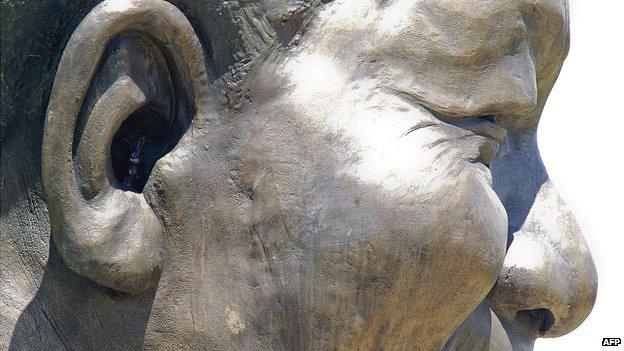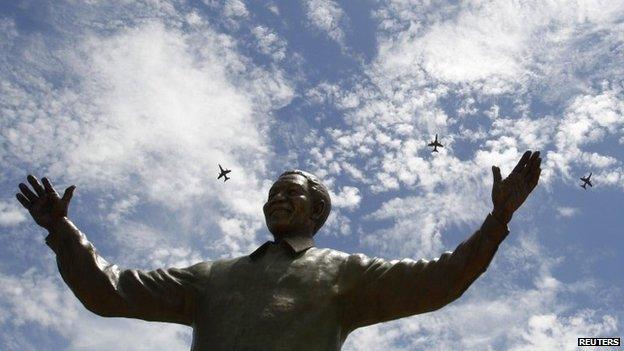Mandela statue: Row over rabbit in Nelson's ear
- Published

South Africa's government has ordered sculptors to remove a bronze rabbit they hid in the ear of a Nelson Mandela statue, unveiled after the former president's death last month.
It wanted to "restore dignity back to the statue", a spokesman told the BBC.
The sculptors reportedly inserted the rabbit as a trademark signature and to denote the haste with which they had to complete the statue.
Rabbit in the Afrikaans language is "haas", which also means haste.
"We don't think it's appropriate because Nelson Mandela never had a rabbit on his ear," Mogomotsi Mogodiri, the spokesman for the Department of Arts and Culture, told the BBC's Focus on Africa radio programme.
"We'd want people to see that statue as a symbol of hope, not about something like a rabbit."
Mr Mandela, who died at the age of 95, was widely acclaimed for his role in fighting white minority rule and promoting reconciliation after being elected South Africa's first black president in 1994.
'No trouser signature allowed'
The nine-metre (30ft) bronze statue was unveiled on 16 December, a day after Mr Mandela was buried.
It stands at the Union Buildings, the government headquarters in the capital, Pretoria.

The statute intends to show that Nelson Mandela reached out to all South Africans
Mr Mogodiri said the sculptors had apologised for any offence caused to the government and Mr Mandela's family by placing the rabbit in the statue's right ear.
"Discussions are on-going about when the rabbit will be removed. Government wants it removed as soon as possible to restore dignity back to the statue," he said.
The sculptors, Andre Prinsloo and Ruhan Janse van Vuuren, said they had added the rabbit to the statue after the department refused to allow them to engrave their signatures on the trousers of the statue, South Africa's Beeld newspaper reported.
They said it also represented the tight deadline they work under.
"The time factor was big and at times we had to work hard," Mr Prinsloo is quoted as saying.
He said the "small symbol" was hidden in the ear and it did not take anything away from the statue.
"You need a long lens or binoculars to see it," he said.
"During the moulding process a lot of people had seen the statue up close and nobody noticed it."
Mr Mogodiri said the sculptors had never asked for permission to put their signatures on the statue, and the government was "taken aback" by their claim that permission had been denied.
"Nothing of that sort happened. If a request was made, we would have considered it," he said.
Mr Mandela died on 5 December after battling a recurring lung infection.